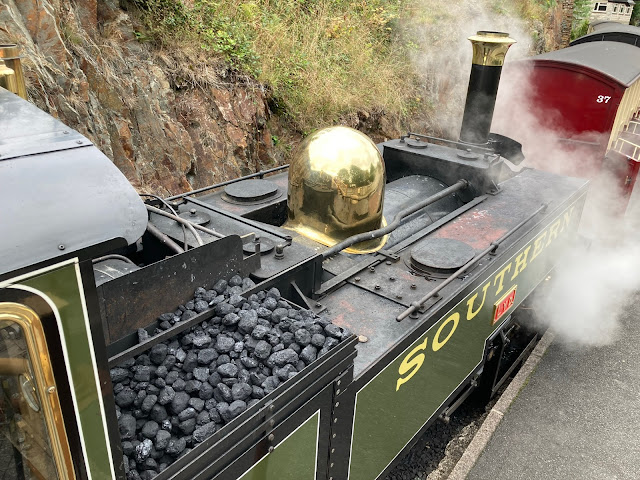Weathering detail: Lyd…
Whilst visiting the Ffestiniog recently I managed to grab a few photos from the bridge at Tan-y-bwlch allowing a study of weathering not usually available to me. I thought a discussion of my findings and how I’d approach the finish might be of use to the casual reader…Tank and boiler tops are often left too clean on people’s models, focusing their weathering more generally on the chassis and roof… what this photo shows is a lovely patina of coal, soot and grime from multiple sources, mixed and churned up across the whole area. It would repay careful observation… how would I recreate this in smaller scales? Notice how everything except the dome is dirty? This would need protecting before we start… then a wash of dirty brown across the whole area, varying the black 33, brown 98 and perhaps a touch of 133. Next airbrushed soot down the boiler in particular… I use a mix of Humbrol metalcote and enamels for this, as per Martyn Welch’s recommendation, currently I use 27004 (2), 133 (1) and 245 (1). Once dry a little black powder around the cross stays, dry brushed gun metal along edges and finally a blunted wooden toothpick or cocktail stick to scratch foot marks into the top of the tanks.
What is interesting, is that my usual approach to roofs (fully matt) would not be accurate on Lyd. Yes there is a dulling of the high gloss finish with soot and smuts, and a collection of grime around the edges of straps and sliders but not a thick matt coating of grime which is how I portray locomotive roofs in general, however note this is not the case on the coaches in the train who do have that look of thick accumulated soot. It would be difficult to achieve this without an airbrush. I’d use a wash if a dark grey to add some build up around the strapping on a model, wiped off in a side to side direction to mimic rain streaking. Once dry a dribble of dark brown might be needed around the strapping, before a sooty mix is airbrushed lightly over the whole thing to soften the edges of the wash, but.being careful to not obliterate the sheen of the model’s paintwork. A finer nozzle n your airbrush would help, I use a 0.3mm top feed with a small cup for jobs like this…
I hope that despite not talking about method, the discussion on what is visible and now to depict that in miniature has encouraged you to have a go… preserved locomotives are often very clean, but observing the weathering that is present and representing that will really life the realism of your models. I would be happy to bring your models to life if you don’t feel confident in applying these sorts of finishes, get in touch for a personal proposal, via the contact form, email (via Facebook), messenger or the forum messaging systems. More soon…



Comments
Post a Comment
Thank you for leaving a comment on my blog - I appreciate you taking the time to share your views. If you struggle to log in, please turn off the ‘block cross-site tracking’ setting in your browser.
James.